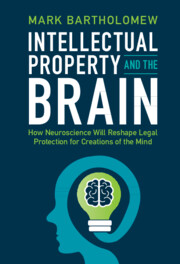 Intellectual Property and the Brain
Intellectual Property and the Brain from Part II - Understanding Audiences for Art and Advertising
Published online by Cambridge University Press: 14 July 2022
The touchstone of any trademark lawsuit is the likelihood of consumer confusion. Courts calculate this likelihood through a series of notoriously unreliable proxies, lamenting that their effort to understand the consumer must be a “shaky kind of guess.” Through the burgeoning field of consumer neuroscience, scientists can now determine when a subject is thinking about one brand versus another. Take, for example, recent research measuring changes in brain blood flow and oxygenation while subjects viewed several well-known trademarks. According to the researchers, each trademark has a different neural signature, with different brain regions reflecting perceptions like “excitement,” “ruggedness,” or “sophistication” upon exposure to the brand stimulus. By viewing these neural signatures and nothing else, researchers could distinguish whether the subject was thinking about Apple or Microsoft, Coke or Pepsi. Studies like this hint at a near future where fMRI readings replace today’s judicial guesswork about consumer perception.
To save this book to your Kindle, first ensure [email protected] is added to your Approved Personal Document E-mail List under your Personal Document Settings on the Manage Your Content and Devices page of your Amazon account. Then enter the ‘name’ part of your Kindle email address below. Find out more about saving to your Kindle.
Note you can select to save to either the @free.kindle.com or @kindle.com variations. ‘@free.kindle.com’ emails are free but can only be saved to your device when it is connected to wi-fi. ‘@kindle.com’ emails can be delivered even when you are not connected to wi-fi, but note that service fees apply.
Find out more about the Kindle Personal Document Service.
To save content items to your account, please confirm that you agree to abide by our usage policies. If this is the first time you use this feature, you will be asked to authorise Cambridge Core to connect with your account. Find out more about saving content to Dropbox.
To save content items to your account, please confirm that you agree to abide by our usage policies. If this is the first time you use this feature, you will be asked to authorise Cambridge Core to connect with your account. Find out more about saving content to Google Drive.